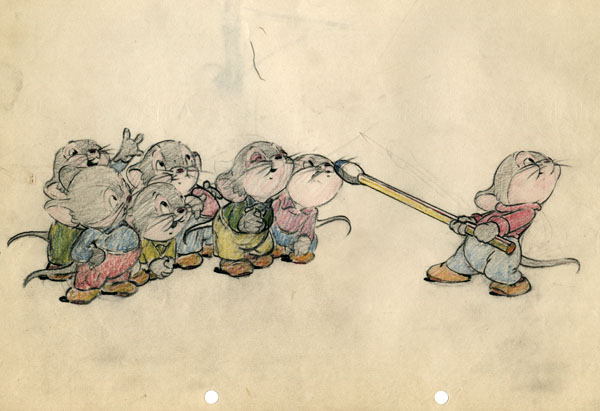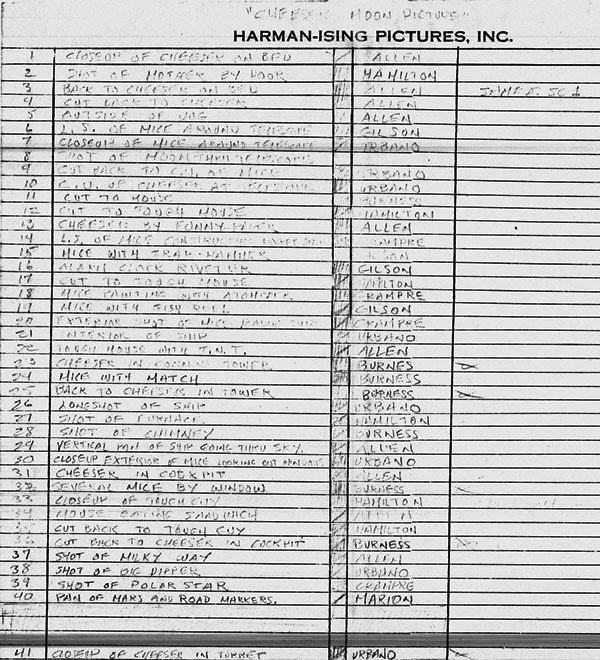
This week, we’re going to the moon (made of green cheese) with Little Cheeser!
 In books, newspaper comics and pulp magazines, science-fiction heroes John Carter of Mars and Flash Gordon engaged in swashbuckling adventures set in outer space. Phillip Nowlan’s Buck Rogers made his debut in an August 1928 issue of the pulp magazine Amazing Stories, first named Anthony Rogers. On January 7, 1929, the character transferred to a syndicated comic strip. Buck Rogers’ success warranted a radio program in 1932, promotional films for the 1933-1934 World’s Fair in Chicago and department stores selling Buck Rogers merchandise around 1936. The phenomenon introduced Americans to the notion of developing space technology and exploration throughout the 20th century. In that regard, it was compelling to 1937 audiences to see Little Cheeser and his friends construct a spaceship after reading the Buck Rogers strip.
In books, newspaper comics and pulp magazines, science-fiction heroes John Carter of Mars and Flash Gordon engaged in swashbuckling adventures set in outer space. Phillip Nowlan’s Buck Rogers made his debut in an August 1928 issue of the pulp magazine Amazing Stories, first named Anthony Rogers. On January 7, 1929, the character transferred to a syndicated comic strip. Buck Rogers’ success warranted a radio program in 1932, promotional films for the 1933-1934 World’s Fair in Chicago and department stores selling Buck Rogers merchandise around 1936. The phenomenon introduced Americans to the notion of developing space technology and exploration throughout the 20th century. In that regard, it was compelling to 1937 audiences to see Little Cheeser and his friends construct a spaceship after reading the Buck Rogers strip.
Little Buck Cheeser was rushed into the production pipeline by April 19, 1937, as Boxoffice magazine reported. Scheduled in between MGM’s February termination of their agreement with producers Hugh Harman and Rudy Ising and forming their own animation department in March, the cartoon isn’t under the “Happy Harmonies” banner but instead “Harman-Ising,” a serendipitous off-shoot name. The cartoon was released exactly eight months later, on December 19.
The animation in Little Buck Cheeser is certainly polished, and less compressed than its predecessor. Animators Bob Allen, Carl Urbano, Pete Burness, George Grandpre and Jim Pabian are credited in the draft, as they were previously. Burness’ animation in Little Cheeser is more pose-oriented; his animation here has a more ‘bouncy’ approach, more familiar in the Tom and Jerry and Warners cartoons he animated. Ancillary animators here include Merle Gilson, Dick Marion (credited with only one shot) and Rollin Hamilton. Hamilton animates most of the scenes with the tough Bowery mouse in the cartoon, with one sequence credited to Bob Allen.
All three previously worked at the Disney studios; Rollin Hamilton, hired in February 1924, was the first employee in his new Hollywood studio. He animated on the Alice Comedies and Oswald the Lucky Rabbit cartoons before he left in May 1928; Merle Gilson started as an assistant animator around 1929. Dick Marion (known later as Dick Hall) was an in-betweener for animator Jack King, but was fired around the end of 1931 when it was revealed he was looking for another job. Fascinatingly, each was involved with Ub Iwerks; Hamilton animated alongside him at Disney’s in the ‘20s. Gilson (along with Jim Pabian) was an in-betweener at Iwerks’ animation studio, assisting him on the early Flip the Frog cartoons. Marion worked for Iwerks much later, around 1935, indicated by a staff photograph.

The three animators also associated with Walter Lantz. Hamilton left Disney for Winkler Pictures, animating on more Oswald entries until Lantz gained the rights to the character. He left to work on Lantz’s early sound Oswalds until around early 1930. Gilson arrived at Lantz for two brief stints, as an animator around 1933-34 (with credits released between February to July 1934), and again in 1937-38 (with releases between May 1938 to January 1939). Marion animated for Lantz around 1937, credited on titles released December 1937 through May 1939. When Marion drifted into Dell Comics, he mostly drew funny animal stories for Lantz’s characters — including Woody Woodpecker and Andy Panda — from roughly 1947 to 1955. Marion briefly wrote the comics, but gravitated to only the drawing duties for a higher salary. (Harvey Deneroff’s column and interview with Dick Marion can be seen here.)
The belief of the Moon being composed of green cheese is, of course, contrary to scientific knowledge, but the hypothesis has its roots in ancient history and folklore. Another assumption occurred in Van Beuren’s Silvery Moon (1933) where the moon consisted of various sweets and desserts. It’s unclear but possible that Little Buck Cheeser influenced stop-motion animator/director Nick Park for his first Wallace and Gromit film A Grand Day Out (1989). In Park’s film, the two construct their own rocket in order to acquire cheese from the moon.
Will Little Cheeser and his pals taste cheese from the moon? Watch the breakdown video and find out!



(Thanks to Michael Barrier, Yowp, Jerry Beck and Frank Young for their help.)


 DEVON BAXTER is a film restoration artist, video editor, and animation researcher/writer currently residing in Pennsylvania. He also hosts a
DEVON BAXTER is a film restoration artist, video editor, and animation researcher/writer currently residing in Pennsylvania. He also hosts a 





















































































“Harman-Ising,” a serendipitous off-shoot name.,
Indeed, when I first saw these cartoons I didn’t realise that “Harman-Ising” was part of the creators’ names. I thought they were made by a guy named Hugh Rudolf. 🙂
This was a fun cartoon, but did they really have to do yet *another* “all a dream” ending? Would it have been that hard to just get the mice back down to Earth?
They probably wanted to go for a traditional “Disney ending”.
Fabulous work as usual Devon. I would love to see if the notes from Milt Gross’s cartoons or The Captain and the Kids are sill around. It would be great to see what scenes Bill Littlejohn animated.
You and me both, brother! There was a veritable powerhouse of strong animators during that period, including Emery Hawkins, Irv Spence and Jack Zander. We can only hope they exist…
Well, I never knew that Harman and Ising disconnected themselves from MGM around the time this cartoon was made. So is it possible that, at the same time, they also created the cartoon, “MERBABIES” for Disney since it sounds like the title has similar sound effects to the typical HAPPY HARMONIES cartoon of the period? You can hear sections of the lion roar used as the whale is getting ready to sneeze! I’m also interested to know how many other HAPPY HARMONIES titles featured work by Jim Tyer, especially regarding the BOSKO titles, but this cartoon is indeed a stunner. If I’m not mistaken, it was only this and the third installment of what we all have come to call the BOSKO trilogy, called “BOSKO IN BAGDAD”, that features impressions of traveling through the starry skies, but this was indeed one of many cartoons in which the main character was looking for a feast in space. “THE MILKY WAY”, the Academy Award-winner, would feature three kittens who are simultaneously dreaming of a trip in a hot air balloon to all kinds of shiny milky treats.
This is one of my favorite Harman-Ising cartoons so thanks Devon. I appreciate the great information and cool original drawings too. One thing about this cartoon that always puzzled me is that first group shot at about the one minute mark. So odd that many of the mice are drawn more naturalistic without the cute faces and cloths. Those mice don’t participate in anything else in the picture so I wonder what they were doing there.
Those mice don’t participate in anything else in the picture so I wonder what they were doing there.
You know what a bunch of freeloaders mice are. They heard there was going to be cheese and there they were.
Me too, the scene is very strange but possibly they are curious mice who are just plain animals. It was common enough for anthropomorphic animal characters to coexist with true theriomorphs.
Don’t forget the music by Mr.Scotttttttttt BRADLEY and the mousa-licious voice of Bereniece Hansell,too.
This is the first time I’ve ever seen this particular cartoon. Fantastic, and quite imaginative for its time. Does anyone know about MGM cartoon sales? I know Paramount and Warner Brothers sold their pre-48s to TV, but did MGM? So many of these MGM cartoons are new to me. I only remember (in the early 1960s), seeing Droopys and Tom & Jerrys at Kiddie Matinees.
Doesn’t Ted Turner still own all the M-G-M cartoons?
Frank – No. Warner Bros. has the MGM cartoons today. Ted Turner bought the MGM film library in 1988 – then sold his companies (and film holdings) to Warner Bros. in 1996.
I stand corrected, Jerry–I shoulda known that factoid!
Same here — I never saw MGM cartoons when I was a kid in the 1960’s. In the 70’s or 80’s I finally saw many of the Tom and Jerry cartoons. (And now I’ve seen them all since they’ve been put on DVD and Blu-Ray — except for the censored two.) However, there must still be hundreds of MGM cartoons I’ve never seen — including tons of Tex Avery cartoons, which I believe include the likes of Scrappy Squirrel and Barney Bear!
Tex Avery didn’t create Barney Bear. He was created by Rudolf Ising in 1939.
The terrific sci fi pulp look and feel. so richly painted, put this one into the cartoon stratosphere. I would have loved to see something so gorgeous, so richly detailed and meticulously 3D, made into an adventure series like Fleischer’s Superman cartoons. Just look at all those rivets at 3:25. That is one solidly built beauty of a spaceship.